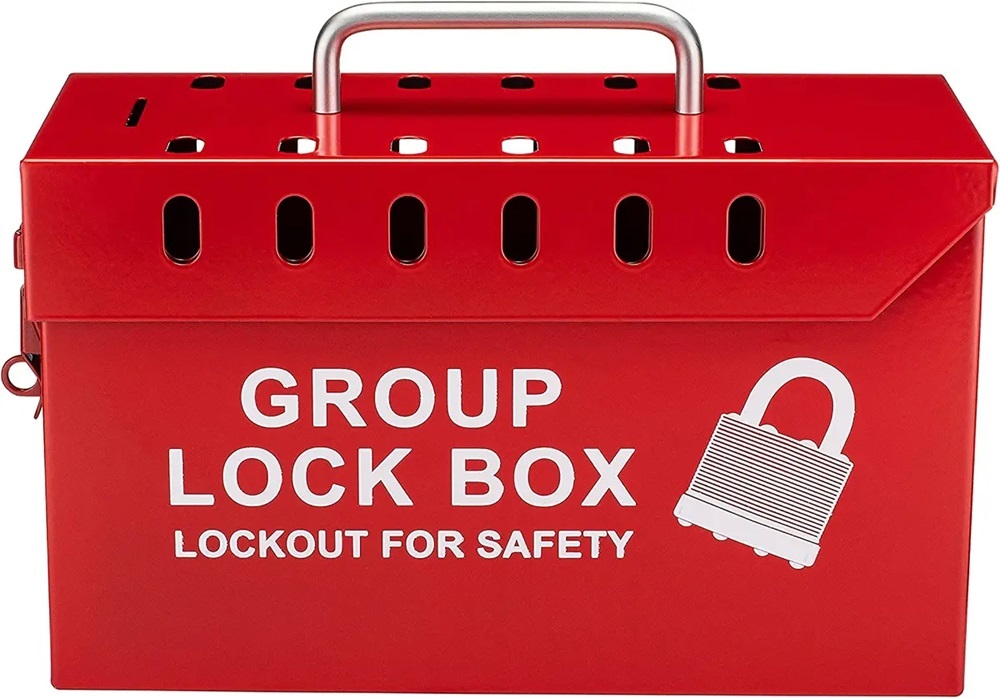Lockout boxes are an essential tool for businesses that utilize heavy machinery and equipment, especially those in the manufacturing, construction, and industrial sectors. Lockout boxes are used as part of a lockout/tagout (LOTO) procedure, which is a safety protocol designed to prevent accidents and injuries when workers are performing maintenance or repair work on machinery, equipment, or electrical systems.
There are several situations when a lockout box is needed. The first is when workers are performing maintenance on equipment or machinery. This can include tasks such as cleaning, lubricating, or replacing parts. During maintenance, it is essential to ensure that the machinery is completely de-energized and cannot be turned on accidentally. This is where a lockout box comes in – it provides a secure location to store the keys to the locks used in the LOTO process, ensuring that only authorized personnel can access the equipment.
Another situation where a lockout box is necessary is when workers are working on electrical systems. Electrical equipment can be extremely dangerous if it is not de-energized correctly, and the LOTO procedure is essential for ensuring worker safety. Lockout boxes provide a centralized location for storing keys and ensuring that only trained personnel have access to the equipment.
In addition to ensuring worker safety, lockout boxes can also help businesses comply with Occupational Safety and Health Administration (OSHA) regulations. OSHA requires that businesses establish a LOTO program for machinery and equipment to protect workers from accidental startup. Failure to comply with these regulations can result in costly fines and legal action.
There are different types of lockout boxes available, including portable lockout boxes and group lockout boxes. Portable lockout boxes are compact and designed for on-the-go use. They can be easily transported from one location to another and typically hold a few locks and keys. Group lockout boxes, on the other hand, are larger and designed for use by multiple workers. They can hold multiple locks and keys and are typically used to control access to machinery and equipment in a specific area.
In conclusion, a lockout box is an essential tool for ensuring worker safety and compliance with OSHA regulations. Lockout boxes are needed whenever workers are performing maintenance or repair work on machinery or electrical systems, and they provide a secure location for storing keys and controlling access to equipment. Different types of lockout boxes are available to suit different needs and situations, making it easy for businesses to establish and maintain a comprehensive LOTO program.
Portable lockout boxes

Portable lockout boxes are an essential tool for ensuring workplace safety during lockout/tagout procedures. These compact and portable boxes are designed to hold multiple padlocks, providing a secure and convenient location for storing lockout/tagout equipment.
Lockout/tagout procedures are used to protect workers from the unexpected start-up of machinery or equipment, which can cause serious injury or even death. Portable lockout boxes play a critical role in these procedures by providing a secure location to store the keys to the padlocks that have been placed on the equipment. By using a lockout box, workers can ensure that the equipment remains safely locked out until all work is complete.
One of the biggest advantages of portable lockout boxes is their versatility. These boxes can be easily moved from one location to another, making them an ideal choice for multi-purpose facilities or job sites. They can be used to secure a wide range of equipment, including electrical panels, valves, and switches.
Portable lockout boxes come in a variety of shapes and sizes, so it’s important to choose the right one for your needs. Some boxes are designed to hold only a few padlocks, while others can hold dozens. Some boxes are made of lightweight materials, while others are constructed from heavy-duty steel for maximum durability.
When choosing a portable lockout box, it’s important to consider the specific needs of your workplace. Some boxes are designed to be weather-resistant, making them ideal for outdoor use. Others are designed with special features, such as clear plastic windows that allow workers to see the status of the equipment without having to unlock the box.
In summary, portable lockout boxes are a crucial component of any lockout/tagout program. They provide a secure and convenient location for storing padlocks, ensuring that equipment remains safely locked out until all work is complete. With a variety of sizes and features available, there’s a lockout box to meet the needs of any workplace. By choosing the right lockout box for your needs, you can help ensure that your workplace remains safe and free from accidents.
Group lockout boxes: Ensuring safety during maintenance work
In industrial settings, it is common for multiple employees to work together on a machine or equipment. During such scenarios, it is crucial to ensure the safety of all workers by using the appropriate lockout/tagout (LOTO) procedures. Group lockout boxes are a vital tool in implementing these procedures to protect workers from hazardous energy sources.
A group lockout box is a centralized device that allows authorized personnel to lock out specific pieces of equipment or machinery. It is used when multiple workers need to work on the same equipment, and a single lockout device is not enough to provide adequate protection. The group lockout box enables each worker to lock out the machinery or equipment independently, ensuring that the equipment is safe to work on and that no one can accidentally turn it on.
Group lockout boxes come in different shapes, sizes, and materials to suit various needs. The most common types of group lockout boxes are wall-mounted or portable. Wall-mounted group lockout boxes are permanently installed on walls near the machinery they protect, while portable group lockout boxes can be moved around to various locations, making them ideal for larger facilities with multiple pieces of equipment.
Portable group lockout boxes come in different sizes and designs, but they all have similar features. They usually have a handle, making them easy to carry, and can be secured with a padlock. Portable group lockout boxes are constructed from durable materials like metal, plastic, or polypropylene, making them weather-resistant and long-lasting.
One of the essential features of group lockout boxes is the clear labeling system. Each lockout point must be labeled with the name of the worker who is responsible for the lockout, the date and time of the lockout, and any other relevant information that may be required. This information helps to ensure that workers can see at a glance which machinery or equipment is being worked on and by whom.
Group lockout boxes are a critical component of LOTO procedures in workplaces where multiple workers need to work on the same equipment or machinery. They provide a centralized device to ensure that equipment is safely locked out, and workers can be confident that they are safe while working. It is essential to train all employees on the correct use of group lockout boxes and to ensure that they are maintained correctly to ensure continued safety.
In conclusion, group lockout boxes are an essential safety device that should be present in any workplace where multiple workers need to work on the same equipment or machinery. They provide a centralized device to ensure that equipment is safely locked out and workers can be confident that they are safe while working.







